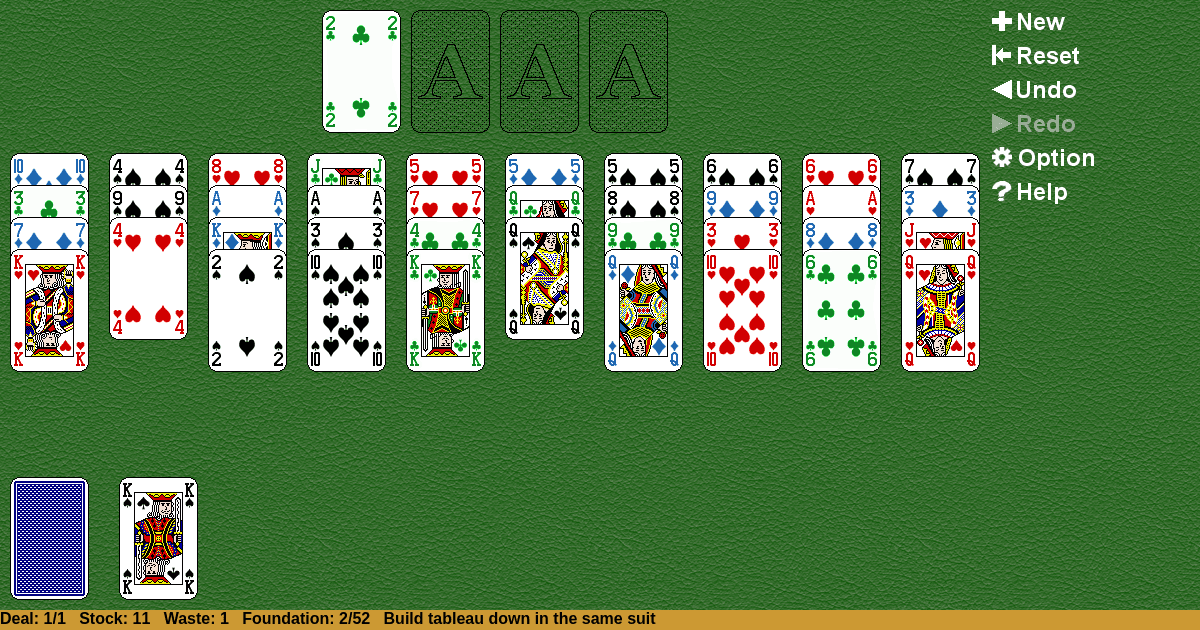Ali Baba
Home |
How to play |
FAQ |
About
How to play Ali Baba?
Game Objective:
The primary goal in Ali Baba Solitaire is to move all cards from the tableau and stock to the four foundation piles, building each foundation up in ascending order by suit from Ace to King.
Setup & Layout:
- Deck: Use a standard 52-card deck.
- Foundations: Remove all four Aces from the deck and place them face up in a row to begin the four foundation piles.
- Tableau: Deal ten tableau piles, each with four cards dealt face up (totaling 40 cards).
- Stock: Place the remaining 12 cards face down to form the stock pile.
- Waste: The waste pile is created during play as cards are drawn from the stock and cannot be immediately played.
Key Play Areas:
- Foundations: Four piles, one for each suit, built up from Ace to King.
- Tableau: Ten columns of four face-up cards each.
- Stock: A face-down pile of 12 cards.
- Waste: A face-up pile where cards from the stock are placed when not immediately playable.
All tableau cards are dealt face up. The stock is face down. The foundations start with the Aces face up.
Ali Baba Solitaire Rules:
- Foundations: Build up by suit, starting with Ace and progressing in ascending order to King (e.g., Ace, 2, 3, …, King of Hearts).
- Tableau: Build down by suit, in descending order (e.g., 9♠ on 10♠).
- Moving Cards:
- Only the top card or a properly sequenced group of cards (all in descending order and same suit) can be moved between tableau piles.
- Any card or valid sequence can be moved to an empty tableau pile.
- Stock and Waste:
- Draw one card at a time from the stock; place it face up on the waste pile.
- Only the top card of the waste pile is available for play.
- No Redeal: Once the stock is exhausted, there is no redeal.
Gameplay:
- Player Actions:
- Move cards from tableau or waste to the foundations if they fit the ascending sequence by suit.
- Build tableau columns down by suit, moving either single cards or sequences in correct order.
- Fill empty tableau spaces with any available card or valid sequence.
- Draw from the stock to the waste when no further moves are possible with current tableau and waste cards.
- Only the top card of the waste is playable to either the tableau or the foundations.
- When No Moves Remain:
- If no moves are possible and the stock is not empty, draw the next card to the waste.
- If the stock is empty and no further moves are possible, the game ends.
Winning & Losing Conditions:
- Winning: The game is won when all 52 cards are moved to the four foundation piles, each built up in suit from Ace to King.
- Losing: The game is lost if no legal moves remain and not all cards have been built onto the foundations (i.e., the stock is depleted and no further moves are possible).
Special Rules & Edge Cases:
- Filling Empty Tableau Piles: Any single card or a valid sequence (descending, same suit) may be moved to fill an empty tableau pile.
- Moving Sequences: Only sequences of cards in perfect descending order and of the same suit may be moved together as a group.
- No Redeal: There is no opportunity to reshuffle or redeal the stock once it is exhausted.
- Waste Pile: Only the top card of the waste pile is available for play; cards beneath it are inaccessible until the top card is moved.
- Stock Exhaustion: Once the stock is empty, play continues only with available moves in the tableau and waste until no further moves can be made.
Definitions of Key Terms:
- Foundation: A pile where cards are built up by suit from Ace to King.
- Tableau: The main play area consisting of ten columns, each built down by suit.
- Stock: The face-down pile from which cards are drawn to the waste.
- Waste: The face-up pile where cards from the stock are placed if not immediately playable.
This ruleset distinguishes Ali Baba Solitaire from other Forty Thieves variants by allowing the movement of entire sequences within the tableau, provided they are in perfect descending order and of the same suit.

Solitaire Collection
About Ali Baba
Rate (Ali Baba)
4.7 / 5
1,916 votes



























































